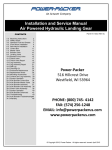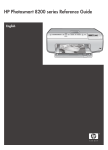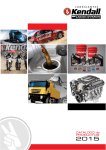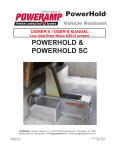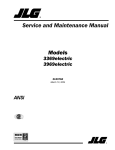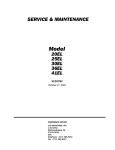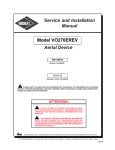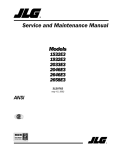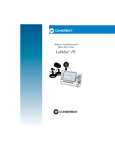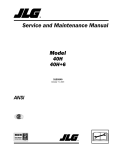Download Work Truck Hydraulic Outrigger System - Power
Transcript
An Actuant Company Installation and Service Manual On-Highway Stabilization System CONTENTS Section Part # 3010003373, REV 0E Page 1.0 Receiving Instructions 2 2.0 Safety Issues 2 3.0 Hydraulic Fluid 4 4.0 Operating Parameters 4 5.0 Hydraulic Out/Down Parts 5 6.0 Hydraulic Out/Down Installation 6 7.0 Hydraulic Out/Down Operation 8 8.0 Manual Out/Down Parts 9 9.0 Manual Out/Hydraulic Down Installation 10 10.0 Manual Out/Hydraulic Down Operation 12 Work Truck Hydraulic Outrigger Systems 11.0 Notes on Installation of Hydraulic 13 System 12.0 Warranty 14 (800) 745- 4142 Fax: (574) 256-1248 [email protected] www.powerpackerus.com © Copyright 2014, Power-Packer. All rights reserved. 3010003373 Installation and Service Manual On-Highway Stabilization System 1.0 Important Receiving Instructions Visually inspect all components for shipping damage prior to installation. Shipping damage is not covered by warranty. If shipping damage is found, notify carrier at once. The carrier is responsible for all repair and replacement costs resulting in damage from shipment. For most current manual, see http://www.powerpackerus.com Product descriptions and specifications are subject to change. For specific versions related to your product, contact us. 2.0 Safety Issues SAFETY FIRST Read all instructions, warnings and cautions carefully. Follow all safety precautions to avoid personal injury or property damage during system operation. Power-Packer cannot be responsible for damage or injury resulting from unsafe product use, lack of maintenance or incorrect product and/or system operation. Do not remove warning labels, tags or decals. Contact Power-Packer when in doubt as to the safety precautions and operations. This manual follows a system of safety alert symbols, signal words and safety messages to warn the user of specific hazards. Failure to comply with these warnings could result in serious personal injury or death, as well as damage to equipment or other property. This is a Safety Alert Symbol that appears throughout this manual. It is used to alert you to potential physical injury hazards. Pay close attention to Safety Alert Symbols and obey all safety messages that follow this symbol to avoid possible serious personal injury or death. Safety Alert Symbols are used in conjunction with certain Signal Words that call attention to safety messages or property damage messages and designate a degree or level of hazard seriousness. The Signal Words used in this manual are WARNING, CAUTION, and NOTICE. WARNING indicates a hazardous situation that, if not avoided, could result in death or serious injury. CAUTION CAUTION indicates a hazardous situation that, if not avoided, could result in minor or moderate injury. NOTICE NOTICE indicates information considered important, but not hazardrelated (e.g. messages related to property damage.) 2 3010003373 Installation and Service Manual On-Highway Stabilization System 2.1 Safety Precautions Failure to observe and comply with the following precautions could result in death or serious personal injury, as well as property damage. • Keep hands and feet away from hydraulic legs during operation. • Do not handle pressurized hoses. Escaping oil under pressure can penetrate the skin. If oil is injected under the skin, see a doctor immediately. • Do not exceed equipment ratings. Never attempt to lift a load weighing more than the capacity of the system. Overloading can cause equipment failure. • Never set relief valve to a higher pressure than specified. Higher settings may result in equipment failure. • Be sure setup is stable before lifting load. Hydraulic legs should be placed on a flat surface that can support the load. Do not bridge. Where applicable, use support pads for added stability. Do not weld or otherwise modify the hydraulic leg to attach a base or other support. • Immediately replace worn and damaged parts. warranty, use only Power-Packer parts. CAUTION To protect Failure to observe and comply with the following precautions could result in minor or moderate personal injury, as well as property damage. • Avoid damaging hydraulic hose. Avoid sharp bends and kinks when routing hydraulic hoses. Using a bent or kinked hose will cause severe back pressure. Sharp bends and kinks will internally damage the hose leading to premature hose failure. • Do not drop heavy objects on hose. A sharp impact may cause internal damage to hose wire strands. Applying pressure to damaged hose may cause it to rupture. • Keep hydraulic equipment away from flames and heat. Excessive heat will soften packings and seals, resulting in fluid leaks. Heat also weakens hose materials and packings. Protect hoses and hydraulic legs from weld spatter. NOTICE Hydraulic equipment must only be serviced by a qualified hydraulic technician. Specific safety messages appear throughout this manual in the left hand column. 3 3010003373 Installation and Service Manual On-Highway Stabilization System 3.0 Hydraulic Fluid Specifications NOTICE Mixtures of hydraulic fluid and fuel oil can cause seal damage resulting in subsequent sticking or sluggish action of the system (and voids warranty). Damaged seals must be replaced. RECOMMENDED HYDRAULIC FLUIDS FOR POWER-PACKER Power-Packer recommends using a quality ISO 32 Anti-wear hydraulic fluid for most applications. If operating in cold temperatures (below freezing) slow operation will occur. If slower operation in cold weather affects your operations, we recommend using a fluid speciallyformulated for cold temperatures. We have found that ISO 15 High Viscosity Index Anti-wear hydraulic fluids work well with Power-Packer systems to -20° F. Some examples of these are: • • • Mobil DTE 10 Excel 15 Chevron Rando HDZ 15 Kendall Hyken Glacial Blu If consistently operating at temperatures below -20°F, then we recommend hydraulic fluids conforming to MIL-PRF-5606H or MIL-H5606A (obsolete). If you have any questions regarding fluid recommendations, please call us. 4.0 Stabilization System Operating Parameters Stabilization legs must be operated within design parameters. Design parameters may vary from leg to leg and must be followed to ensure expected behavior and a safe operating environment. Leg parameters are documented on each part number specific drawing. Stabilization systems must be installed and operated within the design parameters of the crane and vehicle that they are intended to stabilize. Failure to do so could result in death or serious personal injury, as well as property damage. 4 3010003373 Installation and Service Manual On-Highway Stabilization System 5.0 Hydraulic Out/Hydraulic Down Parts List ITEM 1 2 3 4 5.1 5.2 5.3 5.4 5.5 PART NUMBER 9010000783 1010002893 1010002896 1010002634 DN12367 15-1130 16-1030 DN10832 532037 Notes: 1. 2. DESCRIPTION STABILIZATION LEG CENTER TUBE EXTEND STABILIZER ARM FIXED STABILIZER ARM BOLT 1/2-13 X 4 GRADE 5 SCREW , 1/2-13 X 5.0 1/2" HELICAL SPRING LOCK WASHER NUT, HEX 1/2 WEAR PAD QTY 2 1 1 1 6 2 8 8 6 These items are contained in hardware kit 1010002738. These items are available individually 5 NOTES 2 1 1 1 1 1 3010003373 Installation and Service Manual On-Highway Stabilization System 6.0 Hydraulic Out /Hydraulic Down Installation Instructions Stabilizer components are heavy. To avoid possible death or serious personal injury, always follow safe rigging and lifting practices. The stabilization system includes a center tube, an extend stabilizer arm with integral hydraulic extend cylinder, a fixed stabilizer arm, two stabilizing legs, and mounting hardware (see assembly parts list). 1. Center Tube Installation. Mount the center tube to the vehicle so that it is supported at the truck frame. Additional support at both ends of the tube as shown in figure 1 is recommended if possible. The tube can be welded or mechanically fastened to the supports. Welding of the tube to the supports is to be done by a certified welder. Proper mounting of the tube is the responsibility of the vehicle manufacturer. Consult Power-Packer for assistance Be sure to orient the center tube (item 2) so the reinforcing weldments are up and the extend side is on the passenger side of the vehicle (same side as the crane). Also, make sure there is access to the extend cylinder ports. See figure 2. Install three wear pads (item 5.5) in the extend side of the center tube as shown in figure 2. Figure 1 6 6 3010003373 Installation and Service Manual On-Highway Stabilization System 2. Stabilizer Arm Installation. The up and down orientation of the bracket on the end of the stabilizer arms (item 3 and 4) can be used to increase the range of mounting height for the stabilizer legs (item 1). The stabilizer legs must be positioned to reach the ground before reaching their maximum stroke of 20 inches. Once the extend stabilizer arm is oriented, install three wear pads (item 5.5) as shown in figure 2. Insert the extend stabilizer arm (item 3) into the center tube. Insert the fixed stabilizer arm (item 4) into the center tube. Secure each stabilizer arm using 5” long ½” bolts (item 5.2), lock washers (item 5.3), and nuts (item 5.4) provided (one per arm). Torque nuts to 57-64 ft-lbs. 3. Stabilizing Leg Installation Mount the stabilizer legs (item 1) to the mounting brackets using 4” long ½ inch class 5 bolts (item 5.1), lock washers (item 5.3) and nuts (item 5.4) provided (three per leg). Torque nuts to 57-64 ft-lbs. Figure 2 Reinforcing Weldments Extend Cylinder Port Access 7 3010003373 Installation and Service Manual On-Highway Stabilization System 7.0 Hydraulic Out/Hydraulic Down Operation Instructions 1. Locate the truck on level ground. Set the truck parking brake and (if necessary) place wheel chocks/blocks under the front wheels before operating the stabilizers. Operators and bystanders must be clear of the stabilizing legs during operation. Moving stabilizers can cause serious personal injury. Stabilizing legs must be on firm, level ground that will not yield under load. If the ground is soft or uneven, use stabilizer pads to increase the bearing area. Failure to do so may allow the vehicle to tip over, which could result in death or serious personal injury. 2. Hydraulically extend the passenger side stabilizer arm. To insure maximum vehicle stability, be sure to fully extend the passenger side stabilizer arm before lowering the stabilizing legs. 3. Hydraulically lower the stabilizing legs until they make solid contact with the ground. Do not lift the truck. Stabilizers increase vehicle stability only if the wheels remain firmly on the ground. 4. To store the legs, hydraulically raise them until they are fully retracted. Then hydraulically retract the passenger side stabilizer arm. Do not move the passenger side stabilizer arm in or out with the legs extended. Damage to the system may occur. Do not move the truck with the stabilizer arm or the legs extended. Property damage or personal injury may occur. During crane operation, the tire on the opposite side of the lifting load should not leave the ground. If this occurs the vehicle could tip over, which could result in death or serious personal injury. If the load is within the rating of the crane’s load radius chart, relocate the truck closer to the load. 8 3010003373 Installation and Service Manual On-Highway Stabilization System 8.0 Manual Out/Manual Down Parts List Figure 3 ITEM 1 2 3 4 5.1 5.2 5.3 5.4 5.5 5.6 PART NUMBER 9010000783 1010002893 1010002894 1010002634 DN12367 15-1130 16-1030 DN10832 532037 2010000507 Notes: 1. 2. DESCRIPTION STABILIZATION LEG CENTER TUBE EXTEND STABILIZER ARM FIXED STABILIZER ARM BOLT 1/2-13 X 4 GRADE 5 SCREW , 1/2-13 X 5 1/2" HELICAL SPRING LOCK WASHER NUT, HEX 1/2 WEAR PAD INDEXING PLUNGER QTY 2 1 1 1 6 1 7 7 6 1 These items are contained in hardware kit 1010002738. These items are available individually. 9 NOTES 2 1 1 1 1 1 1 3010003373 Installation and Service Manual On-Highway Stabilization System 9.0 Manual Out/Hydraulic Down Installation Instructions Stabilizer components are heavy. To avoid possible death or serious personal injury, always follow safe rigging and lifting practices. The stabilization system includes a center tube, an extend stabilizer arm, a fixed stabilizer arm, two stabilizing legs, and mounting hardware (see assembly parts list). 1. Center Tube Installation. Mount the center tube to the vehicle so that it is supported at the truck frame. Additional support at both ends of the tube as shown in figure 3 is recommended if possible. The tube can be welded or mechanically fastened to the supports. Welding of the tube to the supports is to be done by a certified welder. Proper mounting of the tube is the responsibility of the vehicle manufacturer. Consult PowerPacker for assistance. Be sure to orient the center tube (item 1) so the reinforcing weldments are up and the extend side is on the passenger side of the vehicle (same side as the crane). Install three wear pads (item 5.5) in the extend side of the center tube as shown in figure 4. Figure 3 10 3010003373 Installation and Service Manual On-Highway Stabilization System 2. Stabilizer Arm Installation. The up and down orientation of the bracket on the end of the stabilizer arms (item 3 and 4) can be used to increase the range of mounting height for the stabilizer legs (item 1). The stabilizer legs must be positioned to reach the ground before reaching their maximum stroke of 20 inches. Once the extend stabilizer arm is oriented, install three wear pads (item 5.5) as shown in figure 4. Insert the extend stabilizer arm (item 3) into the center tube. Secure the extend stabilizer arm using the indexing plunger (item 5.6) provided. Insert the fixed stabilizer arm (item 4) into the center tube. Secure the fixed stabilizer arm using 5” long ½” bolts (item 5.2), lock washers (Item 5.3), and nuts (item 5.4) provided. Torque nuts to 57-64 ft-lbs. 3. Stabilizing Leg Installation. Mount the stabilizer legs (item 1) to the mounting brackets using 4” long ½ inch class 5 bolts (item 5.1), lock washers (item 5.3), and nuts (item 5.4) provided (three per leg). Torque nuts to 57-64 ft-lbs. Figure 4 11 3010003373 Installation and Service Manual On-Highway Stabilization System 10.0 Manual Out/Hydraulic Down Operation Instructions 1. Locate the truck on level ground. Set the truck parking brake and place (if necessary) place wheel chocks/blocks under the front wheels before operating the stabilizers. Operators and bystanders must be clear of the stabilizing legs during operation. Moving stabilizers can cause serious personal injury. Stabilizing legs must be on firm, level ground that will not yield under load. If the ground is soft or uneven, use stabilizer pads to increase the bearing area. Failure to do so may allow the vehicle to tip over, which could result in death or serious personal injury. 2. Disengage the indexing plunger. Manually extend the passenger side stabilizer arm to full extension and secure using the indexing plunger. To insure maximum vehicle stability, be sure to fully extend the passenger side stabilizer arm before lowering the stabilizing legs. 3. Hydraulically lower the stabilizing legs until they make solid contact with the ground. Do not lift the truck. Stabilizers increase vehicle stability only if the wheels remain firmly on the ground. 4. To store the legs, hydraulically raise them until they are fully retracted. Then manually retract the passenger side stabilizer arm and secure using the indexing plunger. Do not move the passenger side stabilizer arm in or out with the legs extended. Damage to the system may occur. Do not move the truck with the stabilizer arm or the legs extended. Property damage or personal injury may occur. During crane operation, the tire on the opposite side of the lifting load should not leave the ground. If this occurs the vehicle could tip over, which could result in death or serious personal injury. If the load is within the rating of the crane’s load radius chart, relocate the truck closer to the load. 12 3010003373 Installation and Service Manual On-Highway Stabilization System 11.0 Notes on Installation of Hydraulic System See figure 5 for identification of pump manifold ports for hose routing. CR (Curb Rear) – hose to extend port of passenger side stabilization leg that extends out RR (Road Rear) – hose to extend port of driver side stabilization leg that is fixed CF or RF – hose to extend port of extend cylinder inside extend stabilizer arm – use either port (hydraulic out systems only) . Return hoses to any return port. All are tied together. Figure 5 Return Ports 13 3010003373 Installation and Service Manual On-Highway Stabilization System 12.0 Warranty For warranty information, please contact the Power-Packer Warranty Claims Department. Warranty Claims Department (608) 296-1107 Fax: (608) 296-1798 Power-Packer 516 Hillcrest Drive Westfield, WI 53964 (800) 745-4142 Fax: (574) 256-1248 [email protected] www.powerpackerus.com 14














